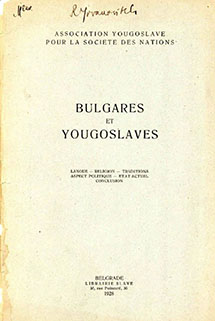
Bulgares et Yougoslaves
booklet published by the "Jugoslav Association for the League of Nations". Content: Language - Religion - Traditions - POlitical Aspects - Current State of the Art - Conclusion
More...We kindly inform you that, as long as the subject affiliation of our 300.000+ articles is in progress, you might get unsufficient or no results on your third level or second level search. In this case, please broaden your search criteria.

booklet published by the "Jugoslav Association for the League of Nations". Content: Language - Religion - Traditions - POlitical Aspects - Current State of the Art - Conclusion
More...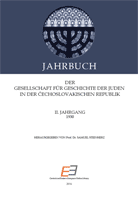
Den nachfolgenden Beschreibungen von Handschriften seien einige allgemeine Bemerkungen vorausgeschickt: Die Kunst des Schönschreibens stand bei den Juden vorwiegend im Dienste religiöser Zwecke. Der Thoraschreiber muss sich allerdings bei der Ausübung seiner Kunst an das Gesetz halten und muss Buchstaben für Buchstaben nach der Norm niederschrieben, dennoch wird ihm eine gewisse Freiheit eingeräumt. In den feinen Strichen oberhalb einzelner Buchstaben, Kronen (hebr. Tagim) genannt, in der gleichmäßigen Schrift, in den vollendeten Schriftzeichen offenbart sich der Künstler. Aber auf Thorarollen darf sich der Schreiber nicht verewigen, ein Buchstabe mehr oder weniger als der überlieferte Text vorschreibt, macht die Thorarolle für das Ritual unbrauchbar. Deshalb sind uns die Namen der Thorarollenschreiber nur auf Grabsteinen und in Gemeindebüchern überliefert, anders aber verhält es sich mit handschriftlichen Gebetbüchern, Psaltern, Memorbüchern und dgl., hier wird dem Künstler freie Hand gegeben. Das Verbot „du sollst dir keine Abbildungen machen“, fand auf Bilder, welche auf Titelblätter, oder im Texte gemalt, keine Anwendung; die Künstler konnten ihre Werke auch signieren. Die Schreibkünstler und Buchmaler in Mähren, soweit sie dem Verfasser bekannt, seien in zeitlicher Reihenfolge hier verzeichnet.
More...
Die Einführung der staatlich angeordneten Zensur, bekanntlich eine der wichtigsten Waffen im Kampfe der katholischen Regierungen gegen die reformatorische Bewegung, fällt in Österreich ungefähr in dieselbe Zeit wie in Deutschland. Auch die Veranlassung für die Einführung ist hier wie dort die gleiche: die reformatorische Bewegung. Als Zeitpunkt der ausdrücklichen Einführung der Zensur im engeren Sinne, der notwendig dem Druck und der Veröffentlichung vorausgehenden obrigkeitlichen Prüfung und Genehmigung des Druckmanuskriptes, gilt für Österreich das Jahr 1528. Die Verordnung Ferdinands I. vom 24. Juli 1528 enthält das strenge Verbot, irgend ein Werk ohne Bewilligung der Obrigkeit in Druck zu legen. Zugleich erfolgte die Einsetzung von Zensurbehörden. Die damit auch für Österreich als Ausfluss der landesherrlichen Gewalt begründete Zensur hat seither bis zum Jahre 1848 bestanden, ohne ihren allgemeinen Charakter wesentlich zu verändern. Das Zensursystem, das durch die Generalzensurverordnung vom 22. Februar 1795 und die Zensurvorschriften vom 10. Oktober 1810 geregelt war, ist erst mit der Proklamation vom 14. März 1848 aufgehoben worden. Auf die Beseitigung der Zensur folgte aber eine Epoche stückweiser Beschneidung der zugestandenen Pressefreiheit Dieser ist natürlich auch die Reaktionsperiode nicht günstig gewesen. Einen Umschwung brachte erst die Verfassungsära mit dem Presse-Gesetz vom 17. Dezember 1862. Dieses hat die Grundlage des Presse-Rechtes für die Länder des alten Österreich gebildet und ist für die Nachfolgestaaten, insbesondere für die tschechoslowakische Republik bis auf die Gegenwart maßgebend geblieben.
More...
on the attempt (beginning in the 1870s) to foster the percveption of Czech-language books and literature in the Jewish families in Bohemia ba a Czech-Jewish calendar.
More...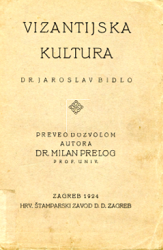
Published in 1924 by HRV. ŠTAMPARSKI ZAVOD D.D., ZAGREB. Translated from Czech to Croatian with permission of the author by Dr. Milan Prelog
More...

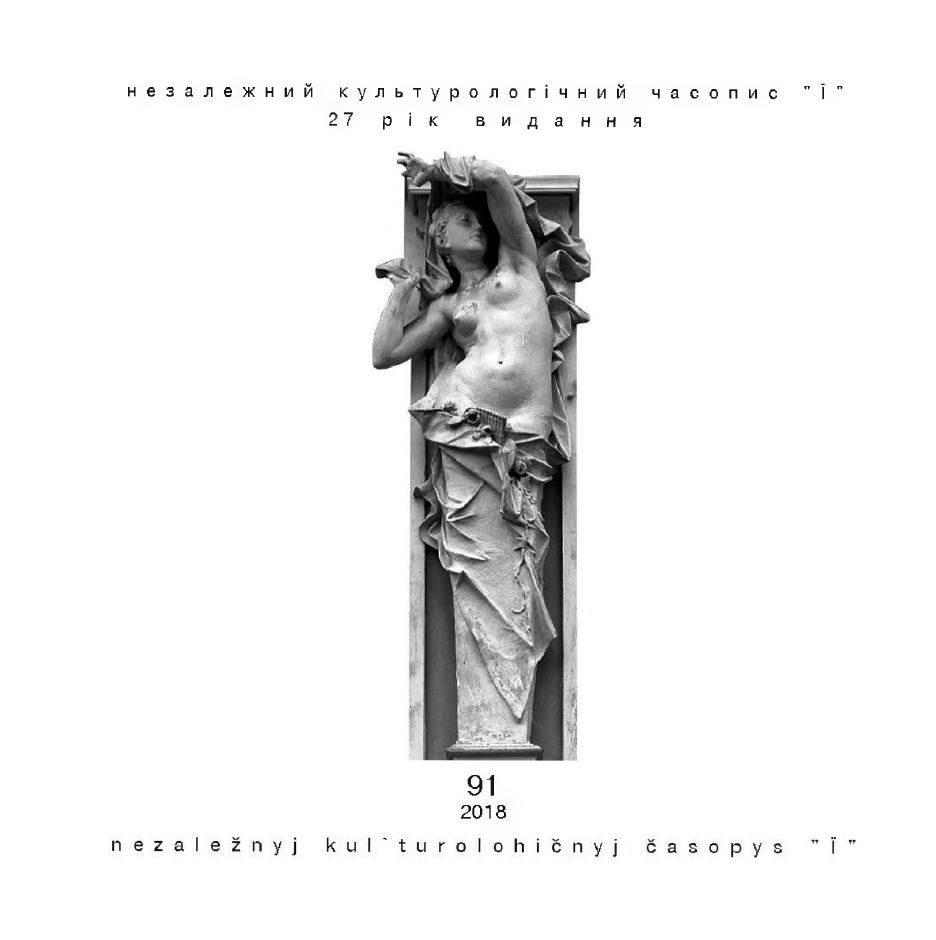
In order to make the thorough mendacity of Putin's rhetoric about "Ukraine as a State of Neo-Nazis" fully evident, CEEOL is offering the Ukrainian Jewish journal ”Ї“ as the strongest possible proof of a habit of "modern Ukrainian and world intellectual thought". The NGO "Ї", an independent cultural organization founded in the late 1980's in L'viv, focuses on modern Ukrainian and world intellectual thought. It offers periodic forums for discussion of issues concerning Ukraine and, among others, Europe, Russia, post-Byzantium, the Muslim Renaissance. It analyzes the current situation in order to develop future socio-political strategies. The organization also publishes "Ї", a quarterly journal dealing with European and Ukrainian issues in politics, philosophy, and culture. It also examines the relationship of Ukrainians with Russians, Poles, Austrians, and Jews and places Ukraine in a modern geopolitical sphere that can further Ukraine's identity as a modern state.
More...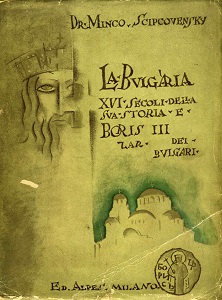

The text is an attempt to answer the question to what extent industrial Łódź was a modern city. The author draws attention to the ambiguity of the term modernity itself, then emphasizes that the development of the city itself was the result of the modernization project of the authorities of the Congress Kingdom. He emphasizes, however, that the project was not warmly welcomed by the Polish public, and the city was perceived as alien and sinister. He tries to explain this phenomenon by emphasizing the ambivalence of the development of Łódź, in which rapid economic growth did not go hand in hand with the development of education or public services. By analyzing the testimonies of people from different social classes, he shows how differently this city was perceived and assessed depending on the place in the social hierarchy that each person occupied. Constituting a terra incognito for the educated and wealthy layers of society, it was a place of enormous emancipation and social advancement for working women. This promotion brought greater benefits than the risks associated with staying in a big city, where exploitation and other negative phenomena to which these classes were exposed were common. In the author's opinion, the ambivalence of Łódź's development was most visible in the sphere of culture, where the opinion of the elites about Łódź as a cultural desert went hand in hand with the real achievements of the city's inhabitants in the field of culturalization. An emanation of this phenomenon was the creation in the city of one of the first collections of modern art in Europe. In conclusion, the author argues that the case of industrial Łódź says a lot about modernity in Central and Eastern Europe and its asynchronous character.
More...
Łódź was the largest industrial city in Europe without a water supply or sewage system. At the same time, electricity arrived there quite late, only in the early 20th century. The city gasworks were the first to be built. A clear development barrier in the construction of these devices was the lack of municipal government during the partitions, and thus the lack of the ability to obtain appropriate funds for the implementation of ambitious projects. The only option was to look for a private investor who would be willing to build and operate the infrastructure in exchange for a favorable concession. After regaining independence, the situation changed, but the local government was deprived of adequate income, so it was also forced to look for companies willing to implement urban investments. This time, unfortunately, the barrier was the lack of decision-making, especially after 1926. As a result of the short-sighted policy of the local government and the reluctance of the central authorities, Łódź lost its chance for modern urban facilities, and the infrastructure created was modest and insufficient.
More...
The subject of the sketch is a reflection on Jarosław Iwaszkiewicz's first meeting with Łódź (in 1911). The writer's essays serve as a source of knowledge about this meeting. From their confrontation with appropriately selected historical documents, a much more general issue emerges - the specific relationship between the veristic and phantasmatic vision/description of the city. At the same time, the sketch is an attempt to answer the question of what significance this first sight of Łódź - that is, the 20th century and modernity - had for Jarosław Iwaszkiewicz's spiritual formation.
More...
The author analyses Pejzaże łódzkie and the lithographs from the series Łódź bez funkcjonalizmu by Władysław Strzemiński in relation to his urban project proposed in the article Łódź sfunkcjonalizowana. She searches for the multilateral relations between the artist's works and texts from the 1930s and the cultural landscape of Łódź at the time. This approach makes it possible to point out the main tensions, crises and internal contradictions of Łódź modernism in architecture and urban planning, Strzemiński's art and his urban experience, but also, more broadly, the crisis of modernism understood as a formation within modern culture.
More...
At the turn of the 19th and 20th centuries, interest in the person and music of Fryderyk Chopin increased, which was reflected, among others, in the celebration of the round anniversaries of his birth (1910) and death (1899). Stanisław Przybyszewski had a strong influence on the interpretation of the composer’s work. Metaphysical elements appear in some of the works of art inspired by Chopin’s music created at that time, such as the works of Wojciech Weiss, Edward Okuń, Feliks M. Wygrzywalski and in the painting "The Last Chords of Frédéric Chopin" by Józef Męcina Krzesz. By depicting composer’s last moments, the artist referred to the tradition of academic painting, contemporary artistic trends, as well as to conventional elements of funerary iconography.
More...
Anna Bilińska was one of the few Polish artists who exhibited and sold their works in London in the late 19th century. The article discusses her participation in exhibitions at the Royal Academy (1888, 1892) and in the pastel shows at the prestigious Grosvenor Gallery (1888, 1889, 1890). Bilińska’s pastel works (folk types, figure studies and portraits) demonstrate her mastery in dry technique, bold stylistic experimentation and understanding of the needs of the art market in London.
More...
This article focuses on the development of authorial graphic portfolios as an independent work of art during the revival of original printmaking in the Warsaw artistic milieu. Before the position of graphic artists was firmly established, painters by background collaborated closely with professional graphic artists, particularly those employed in lithographic workshops. For some, such as Franciszek Siedlecki and Feliks Jabłczyński, graphic portfolios also became an important form of artistic expression.
More...
An analysis of the condition of art would seem incomplete without taking into account the reflections of Wacław Berent, presented in Próchno in “Chimera” around 1900. Taking an external perspective on the internal decay of bohemia, the author seems to agree with the universalism of Leonardo da Vinci’s thought, whose theses, translated by Miriam, appeared in the last issue of the magazine. The necessity to wait out the bad times, mentioned by Leonardo in The Last Lecture, awakened in the writer a desire to take responsibility for art, to find cultural continuity and to deepen the reflection on its mission.
More...
The paper discusses the first Polish-language text “On Aesthetic Education” ["O wychowaniu estetycznym" (1903)] on the postulate of general aesthetic education of citizens by the writer, pedagogue, and publisher Janina Mortkowiczowa, and explores the educational and philosophical frameworks that she uses to support her argument, showcasing the author’s extensive understanding of intellectual culture in Western Europe and its meaning in the Polish context. The paper’s arguments make a case for “On Aesthetic Education” being more than just the first Polish text addressing the importance of cultivating an aesthetic sensibility, but also one of the earliest texts in the 20th century discussing art theory, explicitly exploring the social impact of art.
More...
Maurycy Bornstein, a Polish-Jewish psychiatrist and one of the pioneers of psychoanalysis in Poland, had a lifelong interest in arts and the phenomenon of creativity. Inspired by Cesare Lombroso and his fin-de-siècle followers, Bornstein published his own interpretation of a genius-madness theory. In the interwar period he was inspired directly by Sigmund Freud or, surprisingly, Ernst Kretschmer, which led to his own synthesis in the early post-war era.
More...
In studies of European architecture around the year 1900, the issue of brick manufacturing facilities continues to be overlooked. In the article, the author addresses this problem concerning the largest establishment of this kind, which operated in Congress Poland and belonged to Kazimierz Granzow. The author also demonstrates that the matter of enlivening brick masses through the utilization of bricks with varied colors, textures, and degrees of firing was of utmost importance to the architects active during that period.
More...